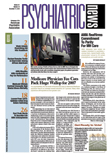Results from the Preschool ADHD Treatment Study (PATS) indicate that children aged 3 to 5.5 years with attention-deficit/hyperactivity disorder (ADHD) appear to benefit from low doses of methylphenidate. Tolerability was lower than expected, however, as 11 percent of patients discontinued use, following parental reports of adverse effects.
Food and Drug Administration labeling states that methylphenidate should not be used in children under the age of 6, but the psychostimulant has become the most commonly used drug for children that age with ADHD, even though the safety and efficacy of the drug in preschoolers had not been tested until recently, wrote the researchers in the November Journal of Child and Adolescent Psychiatry.
“This study demonstrates that medication can be a safe and effective component of treatment for preschool children with ADHD,” commented David Fassler, M.D., a clinical professor of psychiatry at the University of Vermont College of Medicine and an APA trustee-at-large, in an interview.“ However, the results also indicate that very young children may be more likely to experience side effects, at least on a short-term basis.”
The PATS trial consisted of eight phases over 70 weeks and included children aged 3 to 5.5 who had a diagnosis of ADHD and had not taken stimulant medications. The trial was funded by the National Institute of Mental Health. Parents at six academic sites were asked to sign consent forms at the start of each phase of the study. Of the 303 patients initially enrolled in the trial at six sites, 165 entered the crossover titration phase, and 95 completed the study's final, open maintenance phase.
The preschoolers responded to doses of methylphenidate of 7.5 to 30 mg/day, with a mean optimal dose of 14.22 +/-8.1 mg/day. By comparison, average dose in the Multimodal Treatment Study of Children With ADHD (MTA) of 7- to 9.9-year-old children was 30.2-41.3 mg/day. Average adult daily dosage is in the range of 20 mg to 30 mg.
“More children taking the active drug showed a decrease of ADHD symptoms than did those on placebo,” wrote Lawrence Greenhill, M.D., of the Division of Child and Adolescent Psychiatry at the New York State Psychiatric Institute, and colleagues. However, they did note a lower effect size among the younger children than those in the MTA study of school-age children. This may have been due not to differential response, but to the complexities and increased attrition of the PATS trial.
“As a group, [the PATS subjects] were more severely impaired than the school-age children recruited for the MTA study,” they wrote.
“This study further reminds us that very young children may differ significantly from older children and adolescents,” said Fassler, who was not involved in the PATS study. “Dosages, response rates, and side effects all vary considerably.”
The results suggest that early treatment is valuable, but several caveats stand in the way of moving the trial's results directly into the clinic. For one thing, the study drug was the immediate-release version, given two or three times a day. The once-daily, controlled duration form of the drug is the most commonly used today and has a further advantage for preschoolers because it can be sprinkled on food.
PATS also had a fairly high attrition rate, which the researchers stated may have to do with the protocol's requirement for parental reconsent at the start of each new study phase and the options for parents to move their children into the open maintenance phase of the trial.
Greenhill and his team suggested that preschoolers be started at low doses of methylphenidate but noted that further studies are needed to test higher doses, especially since conventional wisdom states that smaller children actually need doses higher than their weights might indicate.
A second part of the study found that overall 30 percent of parents reported adverse events in their children during the trial—from 16 percent to 30 percent of subjects taking the study drug and 15 percent to 20 percent of subjects on placebo. The most frequently reported events included emotional outbursts, difficulty falling asleep, repetitive behaviors/thoughts, irritability, and decreased appetite. Emotional lability and some ADHD behaviors (such as restlessness and impulsivity) were significantly associated with withdrawal from the study. These may have been due as much to lack of medication efficacy as to the action of the drug, said the researchers.
Reports from the manufacturer of the deaths worldwide of 14 children over four years taking mixed amphetamine salts raised concerns about the cardiac safety of psychostimulants and caused Health Canada to temporarily withdraw that formulation from the market for six months in 2005. That event also prompted the PATS researchers to monitor cardiovascular outcomes in the study. Five subjects experienced a transient rise above average in blood pressure, but researchers did not discontinue medication for any cardiovascular reason.
Clinically, said the researchers, “those preschoolers with ADHD on methylphenidate treatment still need to be carefully monitored. Other [adverse events] that are stable (for example, appetite reduction, trouble sleeping) may be managed with dose reductions, giving medication after breakfast, and providing healthy snacks before bedtime.”
“I would certainly concur with the authors' recommendation that physicians and parents of preschool children with ADHD should carefully evaluate the risks and benefits of medication before initiating treatment,” said Fassler. “I would also agree that very young children should be followed closely and seen often to ensure that treatment is effective and to monitor for possible side effects.”
“Efficacy and Safety of Immediate-Release Methylphenidate Treatment for Preschoolers With ADHD” can be accessed at<www.jaacap.com> by clicking on “Archive” and then “November.”▪
